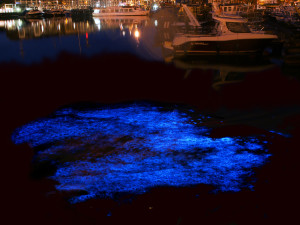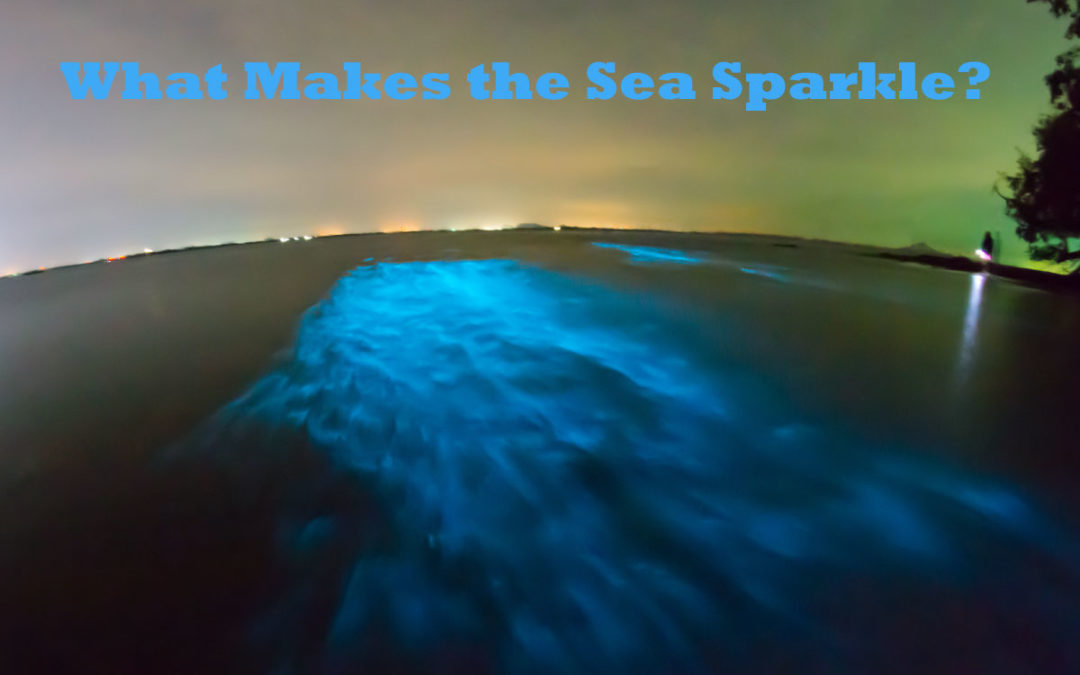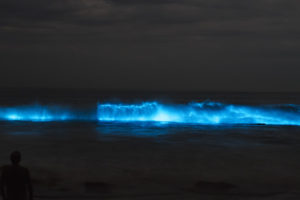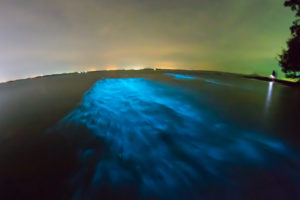A Glow in the Dark Sea Creature
Next time an evening stroll takes you to the seashore, your wet footprints may surprise you by glowing in the dark! Though many marine organisms have the ability to glow, called bioluminescence, it’s likely that the single-celled Noctiluca, also known affectionately as “sea sparkle” is responsible for your glowing footprints!
The phenomenon is also seen as shining blue-white surf or the luminous wake that boats create. Noctiluca makes unpredictable appearances along the coast, washing up on shore to the delight of barefoot beach strollers. The planktonic organism resembles a short-ribboned balloon due to its “tail” and a fluid-filled cellular cavity that buoys it to the ocean’s surface. Noctiluca belongs to a group of organisms known as dinoflagellates, a tongue-twister name derived from the Greek words for whirling and tail, referring to its ‘tail’ or flagella.

Noctiluca scintillans © Hans Hillewaert
Dinoflagellates are believed to be among the most ancient of living things, considered by those who study the origins of life to be the ancestral pool from which both plants and animals arose. Their placement within the tree of life is not clear; some scientists classify them with unicellular algae, other with the protozoans since they are carnivorous, not photosynthetic and are mobile, swimming with their flagella.
Most people are already familiar with dinoflagellates that cause shellfish poisoning and the “red tide.” Others, like Noctiluca, can glow, though it is not clear why this capacity to emit flashes of bright light evolved. Some believe it may be a scare tactic to frighten predators, akin to shining a spotlight in a burglar’s eyes. How they turn the lights off and on is a mysterious process affected by changes in water pressure, salinity, temperature, and light.
A virtual giant among flagellates at one-hundredth of an inch, Noctiluca scavenges the sea as a predator of plankton such as diatoms and larval crustaceans that it captures with an immense feeding tentacle. When the urge to reproduce takes hold, it need not search for a partner. The creature simply doubles its genetic material and splits in two lengthwise.
Favorable ocean conditions occasionally allow the creatures to reach amazing densities. A handful of seawater may hold millions—making them visible to the naked eye, and dazzling lucky observers with their subtle luminescence. One of the best places in the world to experience this phenomenon up close is at Bioluminescent Bay, Puerto Rico. I was lucky to visit this location a couple of years ago, taking an evening tour on a boat, whose wake glowed brightly in the pale moonlight, and it was clear to us that the name “sea sparkle” is a fitting tribute to a beautiful species.
Resources for Learning More
Learn more about Noctiluca, dinoflagellates, and the fascinating phenomenon of bioluminescence; how it works and the many creatures that glow in the dark including fireflies, deep sea fish, and even mushrooms.
- A TED talk on The weird, wonderful world of bioluminescence by Edith Widder
- The Bioluminescence Web Page
- The National Geographic Society page on bioluminescence
- The Encyclopedia of Life page on Noctiluca
- The Tree of Life page on Dinoflagellates





